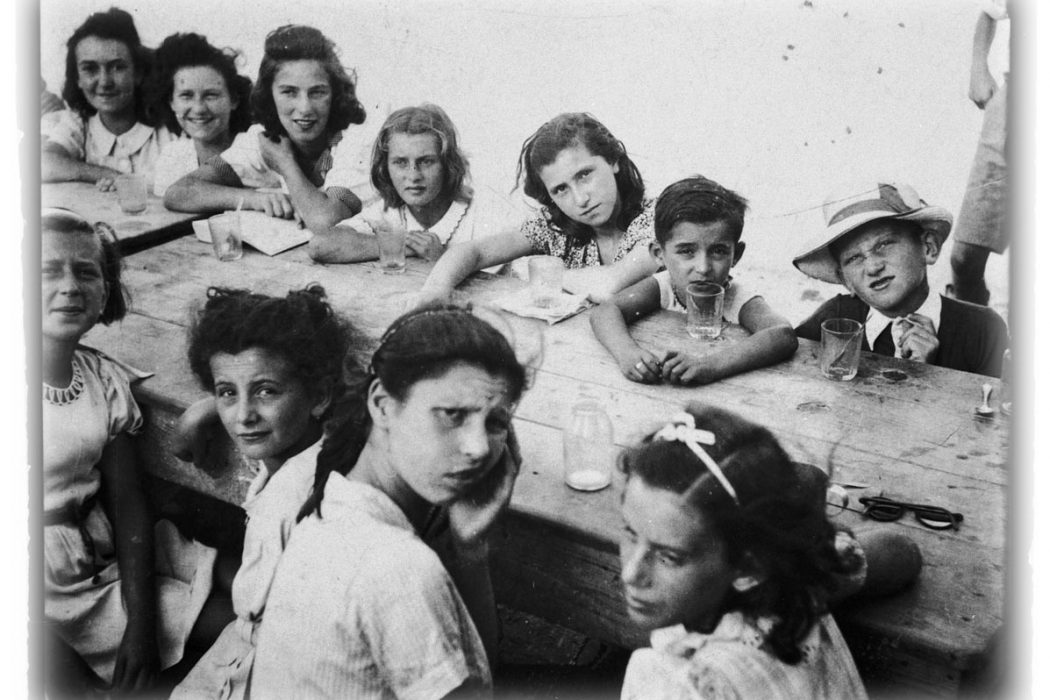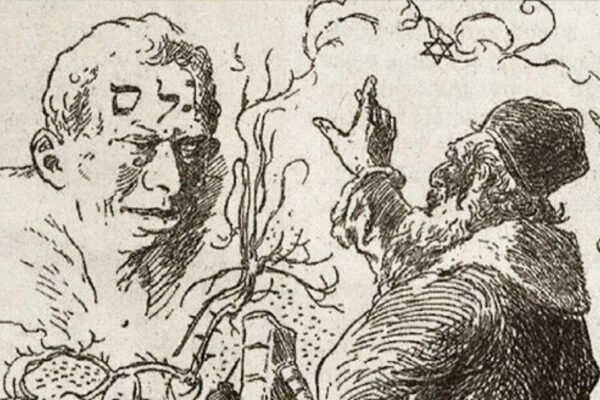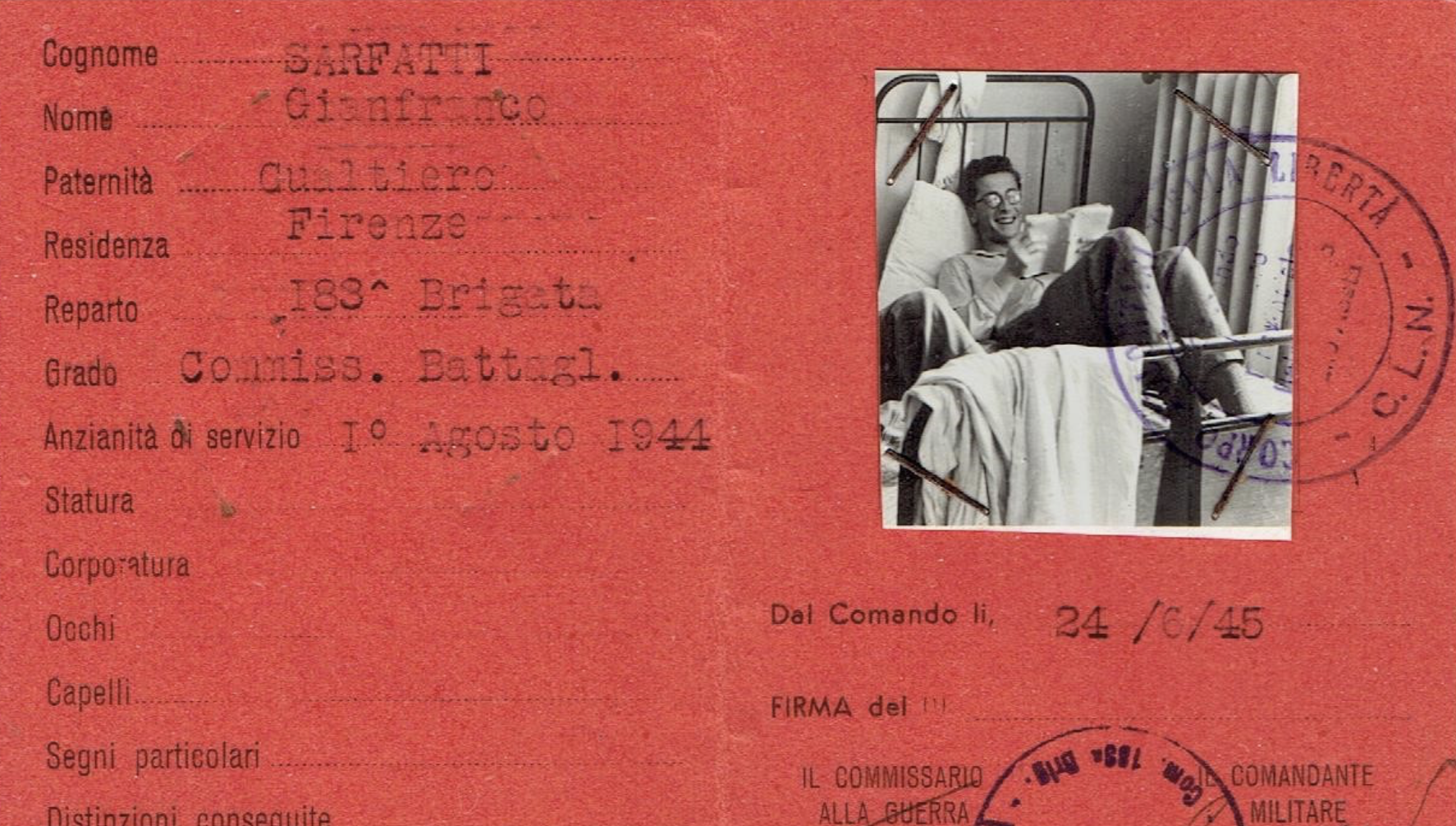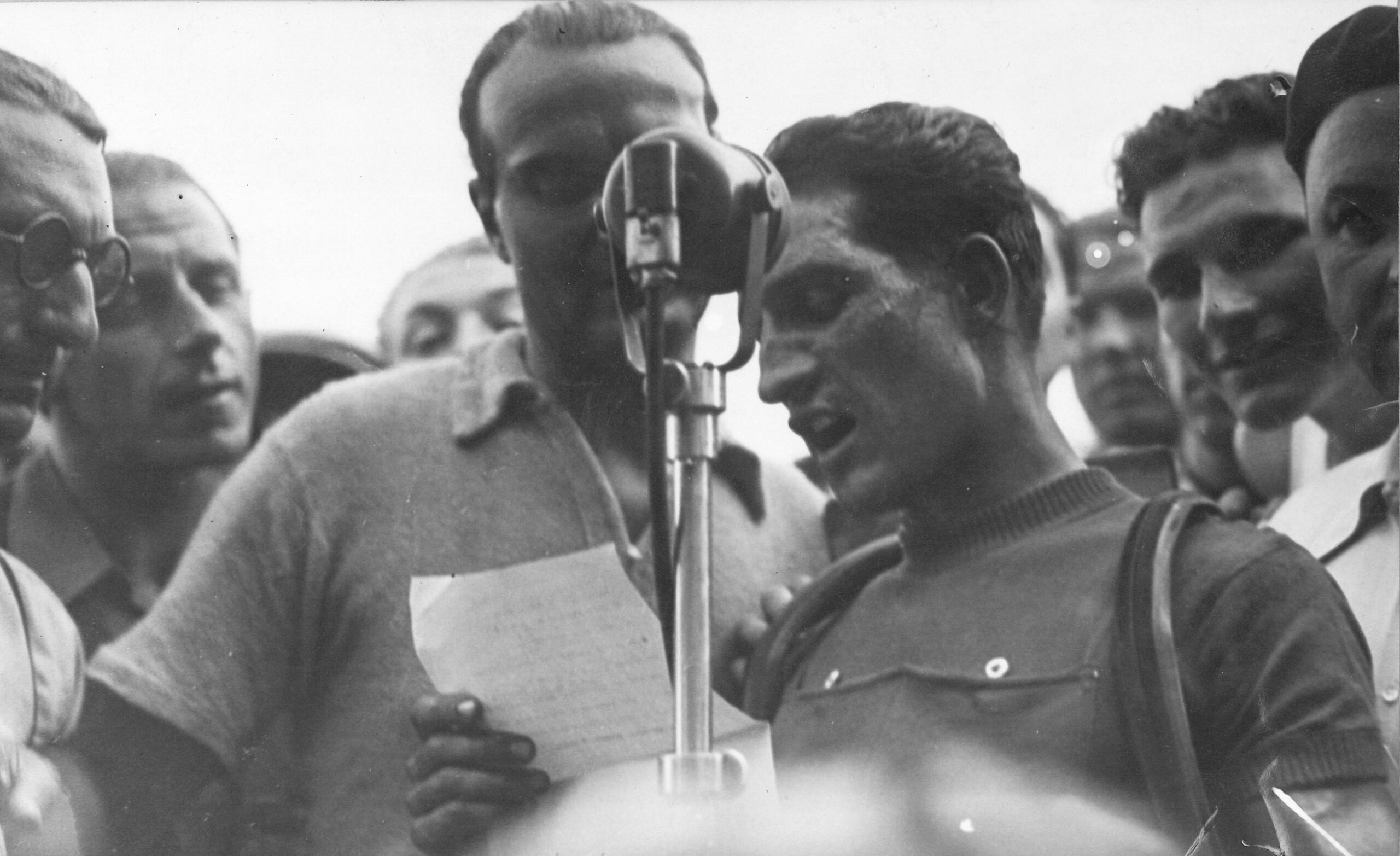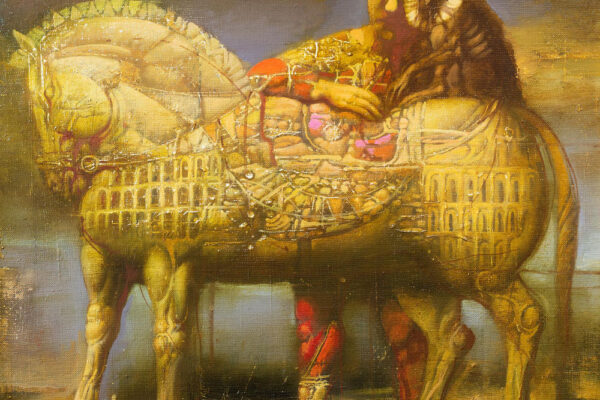Carlo Spartaco Capogreco is considered one of the foremost international experts on the history of Civilian Internment during Fascism. Currently, he is Professor of Contemporary History at the University of Calabria and Scientific Advisor for the Foundation Jewish Contemporary Documentation Center in Milan. Among his other writings of note are Il piombo e l’argento (Rome: Donzelli, 2007); Renicci (Milan: Mursia, 2003); Ferramonti (Florence: La Giuntina, 1987). He has contributed entries and essays to the Encyclopedia of Camps and Ghettos (Bloomington, IN: Indiana University Press, 2018); La Shoah in Italia (Turin: Utet, 2010); Dizionario dell’Olocausto(Turin: Einaudi, 2004); Dizionario del Fascismo (Turin: Einaudi, 2002); Dizionario della Resistenza (Torino: Einaudi, 2001); and has also edited and annotated the critical edition of Maria Eisenstein’s L’internata numero 6 (Milan: Mimesis, 2014).
The train that left Ljubljana in the early hours of July 24th, 1942 with somewhere between 300 and 400 people crammed in the cars, without water or food, arrived at San Giorgio di Nogaro around midday. That’s when we were told that our destination was the concentration camp of Gonars. They moved us via local train to Bagnaria Arsa and, from there, we walked in rows of four between fields, along a dusty road. When we reached the first town larger than a hamlet—I think it was Fauglis— we were met by a crowd of women, children and elderly people. We looked awful: we were sleepy, long bearded, poorly dressed, thirsty and hungry…. Soldiers with bayonet guns led us at five meter intervals. The women and children started screaming: “Robbers, rebels, murderers, criminals!” and we were pelted with rotten fruit and tomatoes. The soldiers did not react. Someone in our group answered, “We are not robbers, but students, taken from our beds just because we are against Fascism! We fight for freedom!” His words had no effect. Clearly the people had been brainwashed by fascist propaganda. There were no young men, probably because they were at the war front. Soon thereafter we heard, far away, the campanile of Gonars, then we saw the water cisterns, the watchtowers, the camps, and the barbed wire fences. That’s how our life of internment began […] 1
This account is excerpted from a conversation I had a few years ago with one of the young, Slav civilians interned in the province of Udine during World War II about his arrival at the camp of Gonars. He and thousands of his compatriots lived through this experience when they were deported to Italy between 1942 and 1943.
In the Yugoslav territories occupied or annexed after the Nazi-fascist invasion of April 6, 1941, Italian forces often resorted to repressive methods that included the burning of villages, shooting of civilian hostages, and deportation of local people to special concentration camps “for Slavs”2. Set up in Italy and in the occupied territories, and almost always supervised by the Italian Armed Forces, these camps forced internees to endure a restrictive and harsh internment that led to thousands of deaths, including those of many children. Yet, the world still knows very little about these events, as well as about the existence of Italian concentration camps during World War II.
“Internment in inhuman conditions”: this was a charge that showed on the list prepared after the war by the Yugoslav government of crimes that the Italian occupiers had committed before and during the war.3 However, the newly formed Italian Republic, “born of the Resistance”, refused to bring to trial even the most egregious cases, including the organizers of these camps, who, as might be expected, were among those that the government of Yugoslavia asked in vain be extradited.4
The refusal to investigate those Italians who committed war crimes, and the erasure of information about fascist personnel who collaborated in carrying them out, have contributed to create a collective understanding of Italian national past history as comforting and self-absolving. Italian colonialism was defined as “humanitarian”; anti-Semitism dismissed as the “product of importation”; and the crimes committed by our troops in the colonies and in the Balkans hidden under a shroud of silence.5 This is how the public learned to embrace the sugarcoated view that, in times of peace, and even more so in times of war, Italians behaved “humanely and with goodwill” toward the people of the countries they invaded; and that, ultimately, Italians themselves were victims of the dictatorship, and of Mussolini’s wars.6
The behavior of left-leaning and anti-fascist political groups as a whole further contributed to strengthen this image in the postwar period because, by invoking “national interest”, it chose to emphasize the merits of Italy’s Resistance rather than the faults of Fascism.7 The conversation about “national kindness” constituted the central nucleus of the hegemonic discourse advanced by the new ruling class. The goal was to pursue reconciliation among all “kind Italians”8 by emphasizing the “virtue” of the general population in condemning the tyrannical nature of Fascism; meanwhile, the latter was presented as a “regime without consensus” and, therefore, as an “extraneous body” to Italy’s history and “national character”. Thus, it was possible to obfuscate the plain truth that the dictatorship—as Carlo Rosselli noticed—self-evidently exposed the vices, weaknesses, and miseries of our people. 9
Having decided to stick to this path, our country, unable to criticize its past mistakes, needed very little to suppress the grave responsibilities it incurred during the fascist ventennio and World War II. Even Italian Jews, who had been among the principal victims of the dictatorship, preferred during the postwar period, when different identities were certainly not viewed favorably, to take shelter behind a memory that was conciliatory. 10
Conversely, the clear brutality of Nazi crimes provided a comfortable alibi for the development of our national forgetfulness. Very little was needed in comparing the behavior of the two allies to relativize and minimize (if not overlook in full) the specific responsibilities of Fascism.11 Thus, Italians, who already in the 1930s had used concentration camps to ‘pacify’ the African colonies, created the comfortable conceit that this emblematic chapter of 20th-century history pertained to them only as victims. 12 And when Giorgio Rochat dared to publish in 1973 one of the few studies that even now is available on the topic of Italian colonial camps, he was accused of “preconceived anti-Italian bias”, and showered with personal insults.13
Though there may be a kernel of truth to the myth of the “kind Italian”—as is the case with every stereotype—, this cannot justify only praising one’s merits when faced with much graver responsibilities. One needs a more equitable meter of evaluation, if one considers that, neither good nor evil, Italians “simply behaved as themselves, with all the traits and limits of national mores that have revealed themselves over the past two centuries”. 14
Some have noticed, with some justification, that the process of distancing the country from these events strengthened Italy’s sense of national identity, and helped the country climb out from twenty years of dictatorship and from a disastrous war. 15 Certainly, however, it contributed to obfuscate reality for decades, creating distorted self-representations in the cultural sphere and in Italian society as a whole. 16 For example, in Franco Vegliani’s novel, La frontiera (1964), an old Yugoslav prisoner on his way to a fascist concentration camp states—in homage to their “kind nature”—that “Italians are, after all, kind people”;17 while, in more recent years, that same “kind nature” pervades the award-winning movie by Gabriele Salvatores, Mediterraneo. 18 Moreover, when in the 1960s a delegation of former Yugoslav servicemen arrived in Italy to pay tribute to the remains of their countrymen who had died in the camp of Monigo, neither the town’s authorities, nor the partisan organizations could point out where they were buried. Indeed, only as a result of this visit did the citizens of Treviso realize that a concentration camp had existed just outside their city. 19 It also so happens that, whether as a result of a technical oversight or of Italy’s desire to deny responsibility, pictures of skeleton-like, starving Yugoslav prisoners in Mussolini’s concentration camps were exhibited as documents of Nazi concentration camps. 20 And—in the context of a happy and nostalgic Italy—the song that became the symbol of the fascist colonial wars, Faccetta nera, would be replayed on Italy’s public television without mentioning the deaths and damage that many people suffered as a result of our colonial practices. 21Finally, to complete a list that could certainly be much longer, one must reflect on the statement made in 1990 by then-President of the Republic, Francesco Cossiga, during a visit to Germany (“We Italians did not experience the horrors of the concentration camps…”);22 or on the comments made by Silvio Berlusconi as Prime Minister (“Mussolini never killed anyone; Mussolini would send people on vacation when he sent them to confinement colony”), which reduce the fascist dictatorship pretty much to the role of tour operator.23
This perspective was enabled by the prevailing historiographic currents which, for a long time, reduced World War II to a representation in which the central, political-military event of the Resistance allowed little room for evaluating the experiences of deportation and internment. 24 Evidence of this attitude in the 1950s was the belief espoused by the publishing house of Italy’s most important political party on the Left that it was “inopportune” to publish an important work of testimony on military internees deported to Germany. 25 Conversely, until twenty years ago, warnings were given about the dangerous depths that “the excesses of ideological memory” might uncover. 26
Returning to the issue of ‘Mussolini’s camps’, citizens and historians forgot the existence not only of the harshest camps reserved to Yugoslav deportees (the category with the greatest numbers persecuted up until Sept. 8, 1943), but also of the ‘milder’ ones, which the Ministry of Interior created, starting in June 1940, to handle the official war internment of enemy aliens and undesirables, and of ‘dangerous’ Italians. In this regard, contributing to the general amnesia was the confusion between what constituted internment and police confinement, which decreased the visibility of the first in favor of the older and better known practice of political confinement. This confusion has allowed for the terms confinee and internee to be used as synonyms; 27 and for the memory of Italian camps—which were active only a few years—to fade behind the more consolidated remembrance of confinement settlements (in italian “colonie di confino”). Contributing to this obfuscation was also the policy to intern prisoners in small towns (in so-called “open internment”: internamento libero, in Italian), which often fooled even internees about their status. 28
Moreover, during the war, Italian concentration camps and “colonie di confino” resided under the same jurisdiction of the Ministry of Interior, often utilizing the selfsame physical and bureaucratic structures, 29 while important “colonie” like Lipari and Ponza—which previously had been restricted confinement venues—were ‘recycled’ as concentration camps. In the latter cases, however, one faces the more complex set of issues tied to the stratification of functions through time experienced by concentrationary structures, which obviously does not pertain to Italy alone. 30 In Italy, the most typical and frequent case was constituted by the change in usage from war imprisonment to civilian internment experienced in many camps overseen by the Royal Army. This change, as is understandable, did not aid an adequate awareness of the reality of fascist civilian internment. 31 Very widespread is also the chronological confusion caused by the activities of civilian camps during the period of monarchical Fascism in 1940-1943 (for example Ferramonti or Gonars), and those of camps instituted during the Italian Social Republic (RSI) and the Nazi occupation in the period 1943-1945 (for example, Fossoli).
In the latter 1980s, I visited—after having completed their mapping 32—every former Italian concentration camp. I was able to assess the state of neglect, if not the complete destruction, of buildings and barracks, and the resulting absence of their recognition as places of memory. With the exception of elderly people who directly witnessed the events, I could not find much recollection at all about events pertaining to internment, not even in areas where camps of a certain size had been operative, or where the war and the partisan resistance had left significant scars and social awareness. Numerous young mayors, whose municipalities had hosted concentration camps, admitted sheepishly to me that they were completely unaware of their existence. 33
In Lanciano, a city that was honored with the gold medal of the Resistance, I spent a whole day locating, with the precious aid of a witness 34, the old “Villa Sorge”, which had been the focus of the first autobiographical memoir published in the postwar period whose actions centered on a fascist concentration camp 35: the villa was nondescript, crumbling, surrounded by huge concrete buildings. In Gonars, the barracks of the largest functioning concentration camp for Slavs in the Peninsula had been completely razed without a single place name or monument to memorialize it. The same fate befell, more or less, the camps of Renicci and Ferramonti. The most extreme case I witnessed was Ventotene: on the small Pontine island, in fact, the ‘confinement citadel’—the great Lager that had been the forced residence of the entire general anti-fascist leadership, and the symbolic emblem of the entire Italian political deportation system—had been ‘normally’ razed to the ground, as if it were any old factory plant that had fallen into obsolescence. 36
I do not think the condition of the sites I visited were much different from the ones described by Anne Grynberg in France during the same period. 37 Yet, as opposed to the important steps that the French establishment subsequently took to complete the historical research and the social ownership of “places of memories” in the past 38, in Italy the process has been slower and more delayed.39 Only in the past few years has there been more careful historiographical and social interest turned toward the history and memory of the 20th century to help clear the haze that until now has covered the events surrounding fascist internment.40 Even here, however, the rediscovery of the Italian camps—and specifically those created by the Ministry of Interior—is used to underscore their merits (what they were not compared to the Nazi camps), rather than to study them in their intrinsic specificity. 41
As David Bidussa recommended in discussing fascist anti-Semitism, it is time to free ourselves of the “demon of analogy with Nazism”. 42 Yet, the delayed rediscovery of the ‘milder’ Italian concentration camps continues to be the opportunity for new and gratifying collective self-representations, which find their fodder both in the widespread numerical overestimation of the role that Jews played in the camps set up by the Ministry of Interior, and in the lesser harshness of these camps vis-à-vis the expectations evoked by their official designation as ‘concentration camps’. 43
Thus, exploited by mass media and influenced by passing trends, local communities have offered fertile grounds for interpretations that are less interested in an accurate historical representation of Italian concentration camps than in their “promotion”. 44 Misleading and disingenuous, these characterizations should be stigmatized and prevented from spreading, and be replaced instead with historical rigor and factual evidence. One should especially remind younger generations that not every anti-Semitism led to Auschwitz 45, and that the Jews that avoided deportation (surviving, therefore, the Shoah) because they were interned in an Italian camp prior to Sept. 8, 1943, do not owe their lives to the ‘kindness’ of the fascist camps or of some local Schindler. What really saved them was primarily the particular geo-political situation established, in September 1943, in the southern part of the Peninsula, since that area of Italy, which housed at the time the majority of interned Jews, was lucky not to experience the vileness and the horrors caused by the Nazi occupation and the fascist republic of Salò (RSI). 46
This book does not set out to reveal hidden mysteries, nor does it wish to put on trial the self-exculpatory excuses of the Italian people. Nor does it claim – by limiting its investigation to the essential issues of the topic under consideration – to constitute a comprehensive history of fascist civilian internment. Its goal is to give visibility to a topic that has been little known through a general overview of the materials, and through a geo-historical mapping of the camps, which is offered here for the first time.
Thinking about the younger generations, I thought it useful to provide first some historical information about the main practices of internment and deportation in Italy, beginning with police confinement and colonial internment, which were the specific models for the later network of civilian internment camps created by Mussolini during World War II. In doing so, and understanding how difficult it is to rely on universally agreed definitions, I propose also a set of terms and examples that help define and distinguish between “concentration” and “internment” camps.
I chose to limit the discussion to the period that goes from June 1940 to August-September 1943. This choice derives not only from the inescapable fact that today far less is known precisely about the camps and the internment policies developed under monarchic Fascism; but also from the awareness that only during that time period (the war years 1940-43) can one correctly talk about fascist internment of civilians, wishing to include in this definition the camps, the laws, and the concentrationary praxis supervised and elaborated by a country that could still be considered a sovereign state. Obviously, the internment and the deportation of civilians that were enacted throughout the Peninsula during the years 1943-1945 by the republican and collaborationist Fascism of the Republica Sociale Italiana were altogether different. 47
I have also considered it appropriate to dedicate substantial attention to the discussion of civilian internment in occupied Yugoslavia and in Italy’s Northeast regions (defined here that as “parallel internment”, since it was completely independent of official specific regulations, as it was outside the observation of the International Red Cross). This is important because—in terms of the numbers and the overall sacrifice in terms of lives and suffering—the deportation of the populations in the nearby Balkan country, and indeed of the Slavic ethnic minorities present in Italy, represents one of the most disturbing facets of fascist civilian internment; a facet that still today, generally speaking, is part of a ‘black hole’ in the history of our country during World War II. 48
The internment of Yugoslav civilians, instead, deserves great attention because it is against this backdrop that one must understand the rescue of several thousand Jews who had, between 1942 and 1943, found refuge in Dalmatia and in other territories taken over from Yugoslavia, which was at the time controlled by Italian Army. This represents a case of a ‘protective internment’ that for a long time was discussed by established historians as the result of a systematic plan of “humanitarian rescue,” 49 but which, rather, inasmuch as it was followed, constituted, also among Jewish refugees, the exception rather than the rule. 50
Image: Children in Ferramonti (1940?), USHMM
Notes
1 Testimony given by Jože Koren (Trieste, Nov. 21st, 1994). An advertising agent, Koren was born in Velike Lašče (Slovenia) on May 10, 1921 and was a student when he was interned in Gonars on July 24, 1942.
2 In fascist Italy, the generic definition “Slavs” applied, with a negative valence, both to citizens of the former Yugoslavia and to Italian citizens belonging to the Slovenian and Croatian minorities.
3 See “Saopčenje italijanskim zločinima protiv Jugoslavije i nienih naroda” (“Bulletin on Italian crimes against Yugoslavia and its people”), edited by the Dražavna Komisija za utvrđivanje zločina okupatora i njihovih pomagača (Yugoslav State Commission on crimes perpetrated by occupiers and their collaborators), Beograd 1946.
4 See Focardi F. and Klinkhammer L., “La questione dei «criminali di guerra» italiani e una Commissione d’inchiesta dimenticata”, in Contemporanea, v. 4 (2000), n. 3 (July); 497-528.
5 On the limits of the purges in Republican Italy, see H. Woller, I conti con il fascismo. L’epurazione in Italia 1943-1948, Bologna: Il Mulino, 1997; R. P. Domenico, Processo ai fascisti, Milano: Rizzoli, 1996; F. Focardi, “L’Italia fascista come potenza occupante nel giudizio dell’opinione pubblica italiana: la questione dei crimini di guerra”, in Qualestoria, 2002, n. 1: 157-183.
6 With regard to how the public’s understanding was co-opted, see P. Jedlowski, Il sapere dell’esperienza, Milano: Il Saggiatore, 1994 (especially 23-38). For the other ideas mentioned in the passage, see A. Del Boca, L’Africa nella coscienza degli italiani. Miti, memorie, errori, sconfitte, Roma-Bari: Laterza, 1992; N. Labanca, In marcia verso Adua, Torino: Einaudi, 1993; R. Siebert, Il razzismo. Il riconoscimento negato, Roma: Carocci, 2003: 133-136.
7 F. Focardi, “La memoria della Guerra e il mito del «bravo italiano». Origine e affermazione di un autoritratto collettivo”, in Italia Contemporanea, 2000, nn. 220-221 (set.-dic.): 393-399; A. Cavalli, “I giovani e la memoria del fascismo e della Resistenza”, Il Mulino, v. 45 (1996): 363.
8 This is how then-attorney general Palmiro Togliatti described the situation on June 22, 1945, as he introduced a decree for amnesty and pardon to the Chambers. See R. Canosa, Storia dell’epurazione in Italia. Le sanzioni contro il fascismo 1943-1948, Milano: Baldini&Castoldi, 1999: 435.
9 See C. Rosselli, Socialismo liberale, Torino: Einaudi, 1973.
10 G. Schwarz, “Identità ebraica e identità italiana nel ricordo dell’antisemitismo fascista,” in AA VV, La memoria della legislazione e della persecuzione antiebraica nella storia dell’Italia repubblicana. Milano: Angeli, 1999: 33; and “Gli ebrei italiani e la memoria della persecuzione fascista (1945-1955)” in Passato e presente, n. 47 (1999), especially 120-122.
11 See N. Gallerano, “Memoria pubblica del fascismo e dell’antifascismo,” in Politiche della memoria. Roma: Manifestolibri, 1993: 7-19; M. Franzinelli, Delatori. Spie e confidenti anonimi: l’arma segreta del regime fascista, Milano: Mondadori, 2001: 18.
12 Giorgio Rochat wrote in the early 1980s that, “We know unfortunately very little about the concentration camps where the populations of the Gebel and of the semi-desert areas [of Cirenaica] were held, because colonial memoirs and historiography completely neglect the issue” (“La repressione della resistenza cirenaica (1922-1931)”, in E. Santarelli, G. Rochat, R. Rainero and L. Goglia, Omar Al-Mukhtar e la riconquista fascista della Libia, Milano: Marzorati, 1981: 155).
13 See E. De Leone. “Il genocidio delle genti cirenaiche secondo G. Rochat”, in Intervento, 1979, nn. 38-39: 83-102; G. Rochat, “Il genocidio cirenaico e la storiografia coloniale”, in Belfagor, 1980, n. 4: 449-455.
14 A. Cavaglion, Ebrei senza saperlo, Napoli: L’Ancora del Mediterraneo, 2002: 48. Cavaglion’s opinion, referencing here the anti-Jewish laws, could be extended to other important junctures of the ventennio and the war period.
15 See M. Fanzinelli, Delatori, cit.: 18-19. In 1946, “there are many more things that people want to forget through amnesty than those that help create a common heritage; but maybe, in an ideal parallel with France, it is precisely the awareness of the fragility of our common heritage that must have convinced the political caste (including the Minister of Justice, Togliatti) to speed down the road to forgetfulness” (M. Salvati, “Amnistia e amnesia dell’Italia del 1946”, in Storia, verità, giustizia. I crimini del XX secolo, M. Flores ed., Milano: Mondadori, 2001: 161).
16 On the construction of identity based on myth, one should point out what George Mosse and Eric Hobsbawm write, respectively, in the “Introduction” to Toward a Final Solution. A History of European Racism (New York: Fertig, 1978, Italian trans. Il razzismo in Europa. Dalle origini all’Olocausto. Roma-Bari: Laterza, 1980), and in On History, London: Abacus, 1991 (transl. De Historia. Milano: Rizzoli: 1997, especially 310).
17 F. Vegliani, La frontiera, Palermo: Sellerio, 1996.
18 On Salvatores’ film, see F. Focardi, “La memoria della Guerra e il mito del «bravo italiano». Origine e affermazione di un autoritratto collettivo, cit., 398; N. Labanca, Oltremare. Storia dell’espansione coloniale italiana, Bologna: Il Mulino, 2002: 469. Released in 1991, Mediterraneo is a “naïve” film that narrates the fascist aggression of Greece through the love stories of Italian soldiers lost on an island in the Peloponnesian Sea. See, E. Monteleone, Mediterraneo: Sceneggiatura del film diretto da Gabriele Salvatores, Milano: Baldini & Castoldi, 1992.
19 Reference to this event—which took place in 1965—is found in a pamphlet that accompanied the exhibition of paintings by Vlado Lamut (a former prisoner at Monigo) that took place in Treviso between April 24 and May 1, 1980, under the sponsorship of the National Association of Italian Partisans (ANPI) and the city council.
20 In the anthology Notte sull’Europa (F. Entasi and R. Forti eds., with Introduction by Carlo Levi, Roma: Aned, 1963), the images titled “Children in Auschwitz” and “After Liberation” belong instead to the Italian concentration camp of Arbe, not the Nazi Lager. Research shows that the prisoner portrayed “after liberation” is the Slovenian Janez Mihelčič, born July 12, 1885 in Babna Polica and deceased in Arbe, February 4, 1943.
21 Carlo Saletti discussed the TV program broadcasted by Raiuno on Nov. 24, 1999 in “Memorie che emergono, memorie che confliggono. Il ricordo della persecuzione ebraica nell’Italia della «Seconda Repubblica» tra revisioni e uso pubblico della storia”, in Bollettino della Società Letteraria di Verona, 2000: 164n7. On the proliferation of Faccetta nera on CDs used for political purposes, or to declare identity flag-waving, see N. Labanca, Oltremare. Storia dell’espansione coloniale italiana, cit.: 468.
22 Interview to Cossiga, L’Unità, December 21, 1990, and the letter to the editor published, in the same newspaper, on Jan. 8, 1991.
23 On the comments by Silvio Berlusconi, see the interview by B. Johnson and N. Farrell published on The Spectator, Sept. 11, 2003.
24 In many countries, the subject of deportation and imprisonment has been considered uncomfortable and “inglorious”: the “passivity” of the internees-prisoners was contrasted, with disdain, to the “active” fight of the partisans-fighters. One need only remember the suspicion, vexation, and suffering that many formerly interned civilian and military men encountered in the Soviet Union and Yugoslavia. With regard to the latter, see for example I. Torkar, Sterben auf Raten, Klagenfurt: Drava Verlag, 1991.
25 The reference here is to Alessandro Natta’s book that Editori Riuniti refused to publish back then. The book was published in 1997 in the volume L’altra Resistenza. I militari italiani internati in Germania, Introduction by E. Collotti (Torino: Einaudi, 1997). On this matter, see also A. Rossi-Doria, Memoria e storia: il caso della deportazione, Soveria Mannelli: Rubbettino, 1998: 40.
26 A. Cavaglion, “Piccoli consigli al ventenne che in Italia studia la Shoah”, Belfagor, v. 55 (2000), n. 326 (March 31, 2000), II: 217.
27 The political confinement (in the form of “police confinement”) existed in Italy since 1926 and was a civilian deportation independent of the state of war, on the contrary of the fascist civilian internment, introduced in 1940.
28 “A few days before Italy entered the war in June 1940, I was arrested in Rome and sent to confinement in San Fede, in the mountain region of Potenza…”: thus, in 1968, Manlio Rossi Doria wrote to Leo Valiani, even though, to be exact, he had been interned (La gioia tranquilla del ricordo. Memorie 1905-1934, Bologna: Il Mulino, 1991: 282). Massimo Mila, in 1945, recalled that Leone Ginzburg “was confined in the lost hamlet of Pizzoli, in Abruzzo”, while, in reality, Ginzburg had been interned (“Ricordo di Leone Ginzburg”, in GL Giustizia e Libertà, May 20, 1945). Natalia Ginzburg herself referred to “confinement” when speaking about the status of internamento libero experienced by her husband (see Lessico familiare, Torino: Einaudi, 1963: 157). The internment of Franco Venturi has also been generally referred to as “confinement” by his biographers: see, for example, F. Venturi, La lotta per la libertà. Scritti politici, L. Casalini ed., Torino: Einaudi, 1996, lix.
29 “In the confinement colony, in particular, no one understood what the difference was between the juridical status of the confined prisoner vis-à-vis that of the interned one, because the treatment, discipline, rules, and duties were the same for both”. Thus wrote Celso Ghini and Adriano Dal Pont in Gli antifascisti al confino, Roma: Editori Riuniti, 1971: 159.
30 One need only think, for example, of the German camps of Mauthausen and Theresienstadt, which were prisoners of war camps during World War I, but became civilian concentration camps under Hitler. Or of Buchenwald, which was transformed from a Nazi Lager (1937-1945) into a ‘special’ Soviet camp that the German Democratic Republic (DDR) has since attempted to obliterate from memory.
31 This was the case, between 1940 and 1943, for the camps of Gonars, Cairo Montenotte, and Renicci. It was also, in the period following Sept. 8, 1943, the transition experienced by the camps of Fossoli, Servigliano Marche, Sforzacosta, and a few others.
32 Some time later, I would present the first list of the camps created by the Ministry of Interior at the International Convention “Italia judaica”, held in Siena June 12-16, 1989; and the one of the camps “for Slavs” (For the most part, supervised by the Military Authorities) at the Convention “Italia 1939-1945. History and memory”, Milano, May 24-26, 1995.
33 We should reflect on the fact that not a single Italian concentration camp was included in I luoghi della memoria, the three volumes work edited by Mario Isnenghi that explains the multiple correlations that exist between events, dates, and physical and symbolic values tied to specific Italian locations (Simboli e miti dell’Italia unita; Strutture ed eventi dell’Italia unita; Personaggi e date dell’Italia unita, Roma-Bari: Laterza, 1996-1997).
34 The man, Luigi Russo, was a lawyer who died Nov. 18, 2000. I remember him here with fondness for the help he gave me.
35 M. Eisenstein, L’internata numero 6. Donne fra i reticolati del campo di concentramento, Preface by G. Giovannelli, Postfaction by C.S. Capogreco, Milano: Tranchida, 1994.
36 A longer elaboration and reflections on that trip can be found in C.S. Capogreco, “L’oblio delle deportazioni fasciste: una questione nazionale.” «questione nazionale». Dalla memoria di Ferramonti alla riscoperta dell’internamento civile italiano.” Nord e Sud, v. 45 (nuova serie, 1999), n. 6 (Nov.-Dec.): 92-109.
37 « Il semblait, à l’évidence, que ces camps ne relevainet pas de la catégorie des “lieux de mémoire” que la France s’était choisis. Dans la plupart des cas, il ne reste aucun signe matériel susceptible de contrarier le travail de l’oubli » A. Grymberg, Les camps de la honte. Les internés juifs des camps français (1939-1944), Paris : La Découverte & Syros, 1999 (first ed. 1991): 10.
38 For example, see J.L. Panicacci. Le Lieux de Mémoire de la Guerre Mondiale dans les Alpes-Maritimes, Nice: Editions Serre, 1997; D. Peschanski, La France des camps. L’internement 1938-1946, Paris: Gallimard, 2002.
39 One had to wait until February 2000 for a representative of the Italian government to give official homage, for the first time, to the victims of a fascist camp (the attaché of then-Italian president, Carlo Azeglio Ciampi, visited at that time the Yugoslav memorial monument inside the cemetery of Gonars). One year earlier, thanks to insistence of the homonymous foundation, the Ferramonti camp had been recognized as a site of cultural and historical importance, an acknowledgment that, unfortunately, has not impeded the further disrepair of the site. See M. Bacchi, “Un viaggio a Ferramonti”, in Cooperazione Educativa, n. 3, 2003.
40 It is significant that an entry on Italian concentration camps can now be found in Einaudi’s Dizionario della Resistenza and Dizionario del fascismo (published in 2001 and 2002 respectively), while it was not present in the Enciclopedia dell’antifascismo e della Resistenza, published by La Pietra in Milano between 1968 and 1988.
41 See T. Grande, “La ricostruzione «in positivo» di un’esperienza di internamento: il campo di Ferramonti”, in Responsabilità e memoria, D. Barazzetti and C. Leccardi eds., Roma: Nuova Italia Scientifica, 1997: 149.
42 D. Bidussa. Il mito del bravo italiano. Persistenze, caratteri e vizi di un paese antico/moderno, dalle leggi razziali all’italiano del Duemila, Milano: Il Saggiatore, 1994: 75. In this sense, just as important—though referred to a broader context—is Pierre Mertens’ warning: “Hitler’s final and most heinous victory is that, Auschwitz being incomparable, he created a formidable monument to all tyrants […], as if there existed a Guinness-book or a hit parade of the horrific” (“L’imprescriptibilité des crimes contre l’humanité dans le travaux du Conseil de l’Europe et dans la convention de l’Onu”, in Le procès de Nuremberg. Conséquences et actualization, Bruxelles: Éditions Bruylant, 1988: 87).
43 See for example what Jean-Claude Favez writes about Italian concentration camps and the Jews interned in Italy prior to Sept. 8, 1943: “Despite being called ‘concentration camps’… they were treated like civilian internees who were citizens of enemy countries” (Une mission impossible? Le CICR, les déportations et les camps de concentration Nazis, Lausanne: Histoire, 1988: 305).
44 The hilarious description of the Ferramonti camp proffered by the local Pro loco association, for example, describes it as the “unique experience of an internment camp that was free from every racial prejudice”. On the “fashion” and the “redundancy of memory” with regard the experiences of Jews in fascist Italy, see A. Cavaglion, Ebrei senza saperlo, cit.: 39 and following.
45 See, D. Bidussa, Il mito del bravo italiano, cit.: 17-18.
46 C.S. Capogreco, “Il campo di concentramento di Campagna e l’internamento ebraico nel Meridione”, in Giovanni Palatucci. La scelta, le differenze, L. Parente and F.S. Festa eds., Atti del Convegno di studi, Avellino, December 20th, 2001, Avellino: Mephite, 2004.
47 For Jews, for example, the status of those interned in camps or in internamento libero changed automatically, at the time, to that of “arrested to be deported” (L. Picciotto, Il libro della Memoria. Gli ebrei deportati dall’Italia 1943-1945, Milano: Mursia, 1991: 855).
48 It was already 1997, when Italian concentration camps during World War II and the internment of Slavic populations were omitted in an excellent historical volume (Friuli e Venezia Giulia. Storia del Novecento, Gorizia: Libreria Goriziana), which however gave ample space to the discussion of interment practices during World War I.
49 See Daniel Carpi, “The Rescue of Jews in the Italian Zone of Occupied Croatia”, in Y. Gutman, E. Zuroff eds, Rescue Attempts During the Holocaust. Proceedings of the Second Yad Vashem International Historical Conference, April 1974, Jerusalem 1977, pp. 465-525; L. Poliakov and J. Sabille, Jews under the Italian Occupation, Paris: Éditions du Centre, 1955 (Italian translation: Gli ebrei sotto l’occupazione italiana, Milano: Edizioni di Comunità, 1956: 131-155); M. Shelah, Un debito di gratitudine. Storia dei rapporti tra l’Esercito Italiano e gli ebrei in Dalmazia 1941-1943, Roma: Stato Maggiore dell’Esercito, Ufficio Storico, 1991 (original edition Tel Aviv, 1986); J. Steinberg, All or Nothing, London-New York: Routledge 1990 (Italian translation: Tutto o niente. L’Asse e gli ebrei nei territori occupati 1941-1943. Milano: Mursia, 1997, 21 passim).
50 The “rescue of Jews” in Croatia substantially helped the young Italian Republic in propagating “the myth of Italians as kind people, by employing the theme of the humanity of its soldiers and people” (D. Rodogno, Il nuovo ordine mediterraneo. Le politiche di occupazione dell’Italia fascista in Europa (1940-1943), Preface by Philippe Burrin, Torino: Bollati Boringhieri, 2003: 459).


